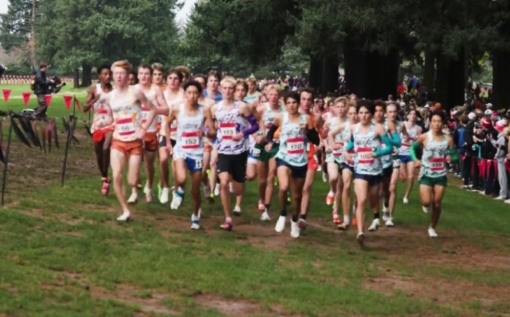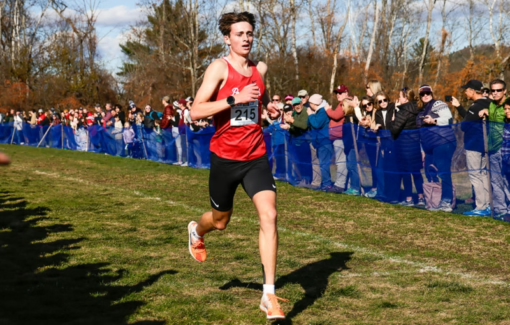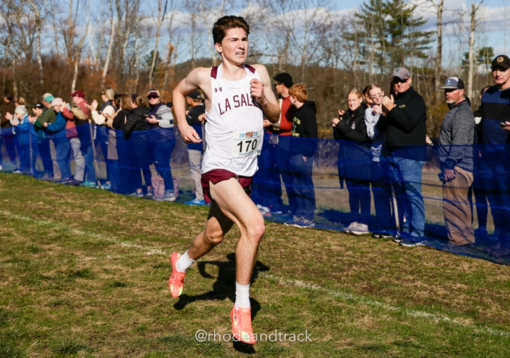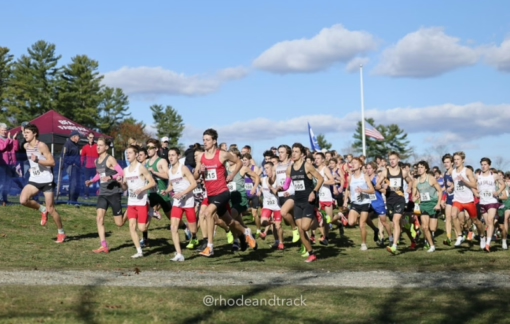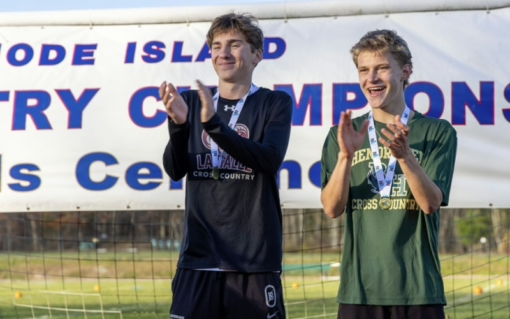
With the Olympic Games occupying her TV set during most of her free time, Alexis Caggiano is in her happy place
It certainly makes sense.
After all, athletics has been part of her life since the age of four. For the star sprinter and recent La Salle Academy grad, it’s a journey that’s taken her from the gymnastic floor to the track oval and, who knows, maybe eventually a long sloping ice track going 80 miles per hour.
Yes, indeed, that’s become the latest endeavor for Caggiano
Shortly after competing at the Nike Outdoor Nationals out in Oregon, she was on her way to upstate New York for the USA Bobsled and Skeleton Rookie Camp. Held at the Olympic Training Center in Lake Placid, she was among 14 athletes that earned an invitation to the weeklong camp in mid July, and one of just four girls.
Caggiano learned of the camp from longtime La Salle girls’ track & field coach Dave Wright. As part of professional development for his job as a Phys. Ed, teacher at the school, Wright attended a seminar more than 20 years ago that took place at the Olympic Training Center and was hosted by the United States Olympic Committee.
“It was put on by them for Phys. Ed. teachers, coaches, and educators to promote Olympic sports in their schools and community; make kids aware that (sports like bobsledding are) a real thing that you can do,” he said. “There are various camps throughout the summer and winter that they put on.”
With speed and power of the utmost importance in the beginning phase, the push-start of the race, football players and track athletes are often recruited for bobsled (two- or four-people sled) and skeleton bobsled (single-rider sled) teams. Wright brought up the idea to Caggiano early in her junior year at La Salle. It was an idea that the North Smithfield native never forgot and was eager to do this summer.
“I was telling her how some sprinters get into bobsledding after their careers,” he said. “It’s like a natural progression because you have to be super strong and have to push to accelerate… We chatted about certain things. I did even think she remembered the conversation.”
She did.
“I was like, ‘Oh, that sounds cool,” Caggiano said. “I was like, ‘Why not try it.”
To get the opportunity to get invited to the camp, prospective candidates had to submit results from a series of physical agility and speed testing that included timed 40- and 10-yard sprints, and measured distances of standing long and high jumps. The tests had to be videoed to prove their validity.
“You have to be a certified strength coach, which I am because you have to validate everything,” Wright said. “It’s testing that is similar to military testing.”
For the running portion of the test, Caggiano clocked a fast 4.92 seconds for the 40y and 1.59 for the 10y. Wright was particularly impressed by what she did in the shorter run.
“She’s just so explosive. I was telling her, ‘It’s stupid how fast you did,” he quipped. “She crushed it. Not many people can run 10 yards like that.”
Once the results were submitted, it wasn’t long before Caggiano got the news she was hoping to hear.
‘We flew back from Oregon (from the NIN) and two days later I did the testing,” she said. “They got back to me the next day. The director of USA bobsled and skeleton sent an email and invited me to the rookie camp at Lake Placid.”
The camp is the first of several camps that potential bobsledders attend to learn the sport. It includes classroom work and training on the initial stage of bobsledding.
“It was a push camp,” Caggiano said. “We were just learning the first part and how you go down the track. It was just the running part and how you jump onto the sled. We just went down an ice track that was 140 meters. The actual ice track that you race on is a mile long. There’s a lot of elevation drop as you go around the curves. It’s definitely something that takes time to learn before you are able to go down that track.”
Caggiano talked about the initial time she had a chance to go down the ice track while pushing the sled. To prevent slipping, she had to wear special ice spikes that have needle-like spikes at the end of the shoe.
White she was able to experience the bobsled, Caggiano primarily used the skeleton bobsled because of her size. She stands just five-feet tall. The skeleton is basically the bottom half of the bobsled.
“The first time I ran with the sled and jumped on it, I thought it was so cool,” she said. “You kind of accelerate like you do out of the blocks. Then you get into max velocity and jump onto the sled while it’s going with you. It’s kind of challenging. There’s a few runs where they kind of let me go.”
At the conclusion of the camp, Caggiano achieved the U23 standard and also the Level C standard.
“(The) A standard is the national team and it works its way down,” she said. ‘The U23 standard is what my goal was by the end of the week. I ended up getting the standard above it, which was the C standard, the push standard for the USA skeleton team.”
Caggiano was not only the shortest athlete at the camp, but also the youngest at age 18.

“For the women, I think I was the youngest by like four or five years,” she said. “For the men, there was a person that was 19. The next woman was like (age) 23 or 24. The other rookie athletes didn’t even realize I just graduated high school. They thought I was much older, until I told them.”
“It was amazing to learn from a lot of former collegiate track athletes as they shared their experience,” she continued. “I was really thankful I got to pick their brains on their experiences and what It was like to run for four or five years in the NCAA. I was kind of glad I got to talk to them and learn and listen to their experience. It was awesome.”
Wright was not surprised by not only Caggiano’s persistence to attend the camp but her success while there. Her determination and focus to excel was something that he has witnessed every since his star athlete came to La Salle her sophomore year. Caggiano transferred to La Salle from Mount St. Charles, which she attended from seventh to ninth grade.
Prior to track and field, she was a hugely-successful gymnast. In middle school, she ranked as high as third in New England. With the repetitive movements, particularly on the joints, gymnasts often experience a high rate of injuries.
Caggiano was no different.
After a decade of competing and three knee surgeries, she decided to call it quits during her freshman year at Mount.
“The highest level I went to (in gymnastics) was level 9 and there are 10 levels,” she said. “Before that, I was competing regionally and won several state championships. My last year being a level 9 gymnast, it was pretty tough. It was kind of tough to get through. After that third surgery, that’s kind of when I decided to move on and try something different.”
That something different turned out to be track and field. It was something she did for a short two-week span at Mount before having her last surgery. She was instantly hooked and decided to pursue her newest interest further at La Salle, which over the years has produced one of the state’s top track & field programs.
“I really liked track and wanted to continue with it. I wanted to go to a different school and kind of start a new beginning,” she said. “My brother was graduating (Mount) as a senior and I was a freshman. He wasn’t going to be there anymore. La Salle has an amazing track program. I really liked track the two weeks I did it. La Salle was a new opportunity and a new beginning.”
Knowing of her background and her series of injuries, Wright made sure his newest athlete did not rush into things and took a gradual approach to building up her strength and conditioning.
“Her sophomore year, she didn’t get the full program of what we do training-wise,” he said. “We kind of had to watch a few things because she was fresh off surgery. We kind of took it easier on her. There were certain things we did to make sure she was healthy.”
One of the first events that Caggiano experimented with was the pole vault, an event that often attracts gymnasts. She achieved a best of nine-feet even to place second at the East Coast Invitational in 2022.
“With the pole vault, it’s just natural. It kind of just happens with body awareness,” she said, making reference to a key trait associated with gymnasts. “It also is really fun.”
While she did enjoy it, Caggiano’’s time with the pole vault was short-lived, and it was all about speed for the diminutive runner. By the end of her sophomore year, one where she achieved bests of 26.45 seconds for the 200m and 12.95 for the 100m, Caggiano was able to impress Wright and his coaching staff so much that she was chosen to run a leg on the school’s Sprint Medley Relay at the New Balance Nationals. The squad, which included seasoned veterans and standout runners, Christian Cormier, Lily Borin, and Caroline Cummings, finished third overall in 4:07.94.
“She knew the sport,” Wright said. “We put her second as a 200 (meter) leg. She got to run with three experienced kids. She got to run with three experienced kids right out of the gates. I think that helped her mature from her sophomore to junior year.”

Caggiano’s times continued to drop as a junior. Her final year proved to be the best of them all with a breakthrough senior campaign that featured significant PRs in events ranging from the 55m dash to the 400m. She thrice broke 25 seconds for the 200m with an all-time best and school record of 24.47 at the State Meet, an effort that earned her a fourth-place finish. Among other highlights was a runner-up placement in the 400m (PR, 57.13) at the states and a podium finish in the 300m at the New England Indoor Championships where she ran a best of 40.64.
Even though she experienced a little discomfort in her knee towards the end of last year, Wright saw a consistent and positive trend starting to happen.
“Her junior year, she just dropped all her times,” Wright said. ”All her weights in the weight room went up. The kid was super strong from gymnastics. You could see that. The limitations were pretty much gone by the time we got to her junior year. She was able to pretty much train the whole program. All her numbers dropped. Personal bests continued to drop.”
“My knee had been going pretty strong. I had a little bit of pain my sophomore and junior years,” Caggiano said. “Once senior year came around, and I was able to do the full training, I started to PR and ran times I really dreamed of and had set goals for in the summer…I had a great outcome my senior year. I couldn’t have asked for a better senior year.”
In the fall, Caggiano will be taking her talents to Loyola University in Maryland. She could tell right away when she visited the school during the year, that it was a place she wanted to spend her next four years.
“From the beginning, it just seemed like the right place and the coach is amazing,” she said. “She’s super positive and really supportive. It just seemed like the right fit, and I wanted to be more in the city. I didn’t want to be at a campus where I’m in the middle of nowhere. It was a great fit all around. For academics, as well. I am a biology major and there is so much opportunity with that.”
Once college is finished, Caggiano is hoping to continue track at some level.
And, of course, skeleton bobsled.
“Athletically, I want to take track as far as I can because I love it so much,” she said. “After that, there’s skeleton. I do want to go to the Olympics for skeleton. That would be pretty cool. Around 2030, that time period. I know it takes time, so maybe even longer like 2034. I’m young, so I have a lot of time, which I’m thankful for.”







